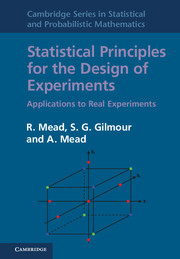Book contents
- Frontmatter
- Contents
- Preface
- Part I Overture
- Part II First subject
- Part III Second subject
- 12 Experimental objectives, treatments and treatment structures
- 13 Factorial structure and particular forms of effects
- 14 Fractional replication
- 15 Incomplete block size for factorial experiments
- 16 Quantitative factors and response functions
- 17 Multifactorial designs for quantitative factors
- 18 Split-unit designs
- Part IV Coda
- References
- Index
15 - Incomplete block size for factorial experiments
from Part III - Second subject
Published online by Cambridge University Press: 05 November 2012
- Frontmatter
- Contents
- Preface
- Part I Overture
- Part II First subject
- Part III Second subject
- 12 Experimental objectives, treatments and treatment structures
- 13 Factorial structure and particular forms of effects
- 14 Fractional replication
- 15 Incomplete block size for factorial experiments
- 16 Quantitative factors and response functions
- 17 Multifactorial designs for quantitative factors
- 18 Split-unit designs
- Part IV Coda
- References
- Index
Summary
Preliminary examples
(a) In an animal feeding experiment, six dietary treatments are to be compared. The diets are all possible combinations of three different levels of molasses at two energy levels. Twenty-four sheep are available and each sheep can be fed a different diet in each of two time periods. It is expected that there will be large differences in nutritional performances between sheep and some systematic differences between the results for the first and second periods. The structure of the experimental units therefore has two blocking classifications, giving a 24 × 2 row-and-column structure. The treatments have a 3 × 2 structure and main effect comparisons, particularly between the three levels of molasses, are the principal area of interest.
(b) An industrial experiment is to be planned to investigate the effects of varying seven factors in a chemical process. Eight treatment combinations can be tested using the same batch of basic material. Eight different batches of material will be available, and it is expected that theremay be substantial differences in output for sample units from the different batches. If it is decided to use two levels of each factor how shall the 64 treatment combinations to be included in the experiment be chosen, and how shall they be allocated to the eight blocks, or batches?
(c) An experiment on absorption of sugar by rabbits is to be designed to compare eight experimental treatments.
- Type
- Chapter
- Information
- Statistical Principles for the Design of ExperimentsApplications to Real Experiments, pp. 363 - 424Publisher: Cambridge University PressPrint publication year: 2012



